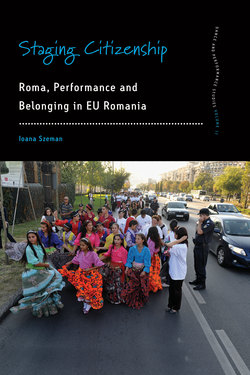Читать книгу Staging Citizenship - Ioana Szeman - Страница 19
На сайте Литреса книга снята с продажи.
‘We Will Build a Beautiful Future Together’ NGO Historiography, Roma Culture and Monoethnic Nationalism
ОглавлениеWe must tell our children that, six decades ago, children just like them were sent by the Romanian state to die of starvation and cold. We must tell mothers in Romania that the Romanian state killed Roma mothers through subjugation and misery. We must also mention that Roma men fighting for the homeland were taken out of the army and sent between Denester and Bug. Education in Romania has the duty to inform and teach the new generations about the Holocaust, just as it has a duty to talk about the period of Roma slavery or about the crimes of Communism.
—Patrasconiu, ‘Exterminarea Ţiganilor’
So went former Romanian President Traian Băsescu’s address for Holocaust Memorial day on 22 October 2007, when he decorated three Holocaust survivors with the National Order of Faithful Service. Denester and Bug, mentioned in his speech, are the two rivers (in present-day Ukraine) that mark the territory where an estimated 25,000 Roma were deported by the Romanian state during World War II and approximately 11,000 lost their lives. Those who returned, including the three survivors decorated at the event, had never before been considered Holocaust victims, as Romania had failed to acknowledge its contribution to the Holocaust until recent EU negotiations and pressure from Israel. The President’s speech included a few sentences in Romani, and a plea to the EU: ‘We need a European policy for Roma. … There is, of course, a need for financial resources, because, for the time being, since the revolution, the funds allocated for the social inclusion of Roma have been insignificant’ (Patrasconiu 2009, no page number). Băsescu ended his remarks with an apology and a promise for the future: ‘Forgive us, brothers and sisters, and we will build a beautiful future together’.
In this chapter I focus on the 2002 Roma Fair held at the Museum of the Romanian Peasant in Bucharest – one of the first events on a national scale representing Roma culture post-1989 – and on political debates before and after EU accession about Roma slavery and the Roma Holocaust. I show how Romanian institutions and officials moulded Roma identity through spatial marginalization and commodification, demonstrated at the Roma Fair in the tension between the museum itself and the marginal spaces assigned to the Roma activists and participants.
I also argue that the framing of Roma culture and Roma history has become increasingly commodified in the celebration of a consumable version of culture and a selective and perfunctory engagement with the past. The Roma Fair offered Roma cultural artefacts for consumption through the commodification of Roma identities in the context of a general expansion of the market and consumer culture in Romania. Indeed, during the autumn following the Roma Fair, the first Romanian branch of the multinational company Pier 1 Imports opened in Bucharest, offering well-off Romanians ‘authentic’ Developing World artefacts and ethnic chic, filtered through Western taste and endorsement, and available at Western prices. Such commodification has maintained the citizenship gap for Roma by harmonizing neoliberalism and monoethnic nationalism.
The state has imposed a form of what Rey Chow defines as ‘coercive mimeticism’: an identitarian, existential, cultural or textual process whereby those defined as ‘ethnics’ are expected to ‘resemble and replicate the very banal preconceptions that have been appended to them, a process in which they are expected to objectify themselves in accordance with the already seen and thus to authenticate the familiar imaginings of them as ethnics’ (2002, 107). The Roma Fair illustrates the tension between the state’s imposition of monoethnic paradigms and the Roma activists’ attempt to bridge the citizenship gap from within those paradigms. I will show how activists at the fair turned a critical eye on the cultural politics of Roma representations across the centuries, and through NGO historiography assessed the construction of national history in Romania. The fair put forward the perspective of minor history and challenged monoethnic national history by including Roma as subjects of national history. It made visible subaltern Roma identities and addressed an emergent Roma counterpublic.1
Lastly, I consider the appropriation and erasure of Roma culture and its survival through oral transmission across generations, using a minor historical and transnational approach to discuss the institution of the Museum of the Romanian Peasant in relation to the construction of Romanian folklore and Romanian nationalism. Focusing on the narratives told by archival evidence, pictures and books at the exhibition, and by the performances, voices and negotiations taking place outside, I point to the cracks that the fair opened up in the grand narrative of monoethnic nationalism told by the museum and countless other institutions in Romania.
